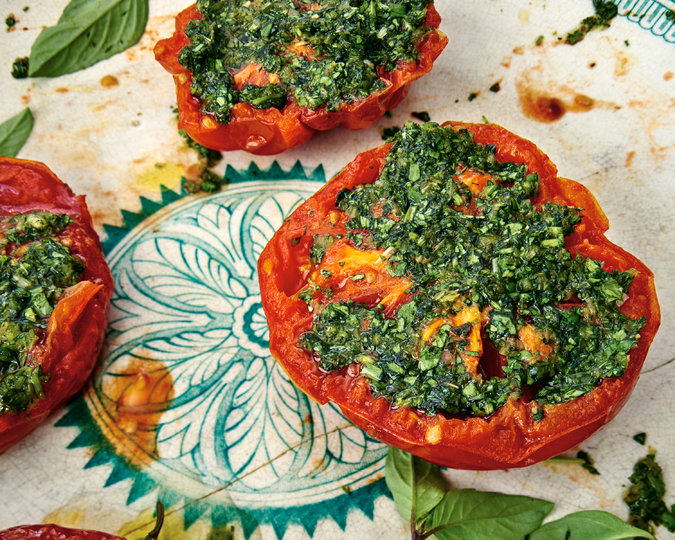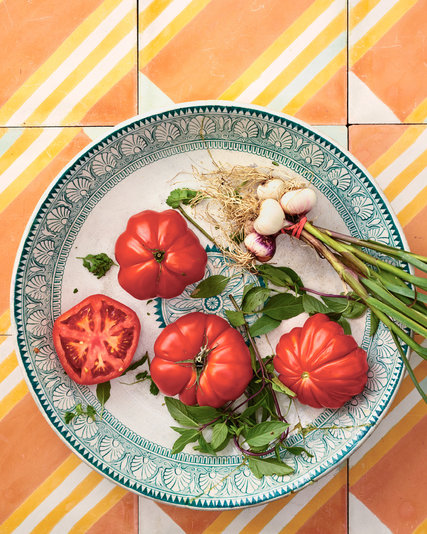Your cart is currently empty!
A Philosophy of Herbs

There are two ways of seeing herbs in error. In my gastronomic memory, the blunt and mostly bald symbol of the first way is the altruistic Signor Giocondo Cavaliere, of the village Amalfi, region Campania, population 5,428 (or so). On a blue May day, three other naïve Americans and I invited him, along with Gennaro, the chauffeur; Giulio, who ran the fish market; Nino, who staked the peas; and an assortment of others to lunch in the white stucco villa we were borrowing.
Things went well through the crisp toasts with oiled acciughe, blistered friggitello peppers from the garden. But when handed a bowl of spaghetti with peas, pancetta, pecorino and mint, Signor Cavaliere allowed a look of mild distress to nest on his damp brow. He twirled a few polite noodles around his fork in silence until, after several minutes, the rattled man had to unburden himself.
‘‘I understand,’’ he whispered directly into my ear, in slow and serious Italian, ‘‘that in America you cook … experimentally.’’ He paused. Our eyes met for a critical moment.
‘‘But here’’ — he waved to include the table, the loquat trees shadowing the high balcony, the citrus air, the deep sea — ‘‘we do not cook in such a modern way.’’
I admitted to him in honesty that I didn’t understand what he was talking about.
‘‘Mint!’’ he almost shouted at me. ‘‘Mint! Can’t be served with pasta!’’ I felt horrible for him, watching him redden. ‘‘Mint is for fish!’’ And his wet head fell into his hands.
He was an herbal provincial. In his way of seeing, shared by much of Italy, to every dish — each olive-oil-marinated melanzana, each spit-roasted bird, each risotto, each plate of golden pasta and accompanying sauce — there corresponds a single herb, or at least an inviolable herbal boundary.
The opposite outlook is held by the globalist optimist who, whether to use what she has, or simply because the devil may care (but she doesn’t), will cheerfully add cilantro instead of parsley to puttanesca sauce, or sage in place of basil to Thai green curry, then puzzle at why the puttanesca tastes nothing like last time, or why the curry brings to mind turkey stuffing.
Seeing herbs clearly demands remembering that their essence is to help. Herbs once were the unique domain of the apothecary and herbalist, the ‘‘root digger and wandering quack,’’ as Hercules cynically appraised Aesculapius. Although herbalists’ mortars and pestles often pounded out false nostrums, herbs do have specific actions on the body, whether animal or human. The deep earthiness of rosemary, the astringency of mint derive from chemical compounds — phenylpropenes and terpenes and sulfides — that plants build as defenses against the threatening bacteria or herbivore.

No matter exactly where its periphery is drawn, the category ‘‘herb’’ contains some of the most beautiful words in the English language. The magical ring of the most familiar has been dampened by common use: Rosemary and lavender, peppermint and cilantro have settled among the humdrum. But chamomile and gentian, hyssop and calendula, holy basil and cupid’s dart and nepitella, lady’s mantle, scarlet pimpernel, angelica, rue, samphire, feverfew and Jerusalem oak — all still tremble with the heavy breath of incantation.
We use herbs; they act. In that, we find answers to all the questions.
To the matter of garnishes: If a sprig of parsley isn’t doing anything on a plate other than waiting to be moved off it, along with the serrated cucumber slice, it isn’t needed. If a sprig of mint will be left sitting pertly in the pudding because it is still on its stem, it isn’t serving.
To the question of how much of an herb to use: As their history as medicine demonstrates, herbs are potent. The exact degree of potency is best ascertained by tasting. If a single leaf of thyme or an edge of curry leaf tastes strong, use sparingly; contrarily, if parsley or cilantro can be comfortably chewed while daydreaming, be liberal. (In general, the rule, as with present-day pharmaceuticals, is discretion.)
To which herb goes with what: The natural affinities tend to be geographical. Herbs that grow in the same climates as the main ingredient with which you’re hoping to pair them will usually cooperate.
If only the devout Sig. Cavaliere had knelt, before lunch, in the terraced garden, he would have seen, with his own eyes, the mint reaching and straining toward the pea tendrils — though I think not even this visual proof would have persuaded such an herbal puritan.





Leave a Reply
You must be logged in to post a comment.